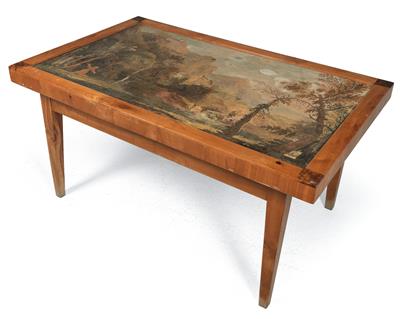Large scagliola top by Wolfgang Köpp von Felsenthal (1738-1807),

Saint Francis receiving the stigmata, Vienna circa 1774–1800, mounted on a frame veneered in cherry wood, set on a table support in cherry, dating from the 19th century, ca. 140.5 x 82 cm, slightly cracked. (MIN)
Wolfgang Köpp Edler von Feldenthal grew up in Eisenstadt, the son of Christian K., painter and architect to prince Paul Esterhazy. From the age of 12 he attended the Academy of Fine Arts in Vienna under the director Martin van Meytens, where he inclined towards the work of Franz Anton von Maulbertsch. In 1760 he went to Wiener Neustadt, and painted altar pictures for Hungarian churches and in 1772 created the ceiling for the parish church of Kalvarienberg in Eisenstadt. Köpp then became drawing instructor at the Theresianischen Ritterakademie in Vienna and began to work with scagliola or stucco marble technique. His first work was presented to Empress Maria Theresia. He improved his technique and became known beyond his own country. He received orders from all of the European courts. In 1774 he became member of the Academy of Fine Arts in Vienna, in 1785 member and professor at the Academy in Florence and in 1787 member of the Academy in Berlin. He appears to have been the first artist in the German speaking world to have used this technique in a larger style. In 1803 in gratitude for his services, Wolfgang Köpp was elevated to the Austrian aristocracy with the title of Prädicate v. Felsenthal. A catalogue of works produced in 1989 as part of a diploma thesis, lists a total of 54 scagliola works by Köpp and his workshop, of which 14 however have disappeared. Further scagliola pieces can be found at St Stephen’s cathedral in Vienna, the parish church of Solymar in Hungary, at the KHM in Vienna, at the court furniture repository in Vienna and at the Landesmuseum Burgenland.
Lit.:
“Verzeichnis über die in dem k. k. priv. Mosaic-Scagliola Kunst- Kabinette befindlichen Stücke. Welche im fürstlich Starhemberg. Freyhaus auf der Wieden im Hofe Nr. 5 Siege N. 24 im 2ten Stock Bey dem Direktir Herrn W. von Köpp zu sehen sind". Vienna 1800.
“Väterländische Blätter für den österreichischen Kaiserstaat”, see Anton Strauss, Vienna, 1814.
Constantin v. Wurzbach, Biographisches Lexikon des Kaiserthums Oesterreich, Vienna 1864.
Heinrich Kneschke, Neues allgemeines Deutsches Adels-Lexicon, see F. Voigt, Leibzig 1864.
Adolf Duschanrk, Der Maler und Mosaizist Wolfgang Köpp ( Eisenstadt 1738–1807 Vienna), thesis, Vienna 1989.
Comparable illustrations:
(1) Aegidius Sadeler II (1586-1629), after Jan Brueghel the Elder (1568–1625): Rocky landscape with Saint Francis receiving the stigmata. (Metropolitan Museum of Art 49.95.1412)
(2) Wolfgang Köpp, Portrait of J. Böhm, copper engraving, 1798.
Esperto: Günther Minichreiter
 Günther Minichreiter
Günther Minichreiter
+43-1-515 60-528
guenther.minichreiter@dorotheum.at
18.10.2017 - 15:00
- Stima:
-
EUR 10.000,- a EUR 15.000,-
Large scagliola top by Wolfgang Köpp von Felsenthal (1738-1807),
Saint Francis receiving the stigmata, Vienna circa 1774–1800, mounted on a frame veneered in cherry wood, set on a table support in cherry, dating from the 19th century, ca. 140.5 x 82 cm, slightly cracked. (MIN)
Wolfgang Köpp Edler von Feldenthal grew up in Eisenstadt, the son of Christian K., painter and architect to prince Paul Esterhazy. From the age of 12 he attended the Academy of Fine Arts in Vienna under the director Martin van Meytens, where he inclined towards the work of Franz Anton von Maulbertsch. In 1760 he went to Wiener Neustadt, and painted altar pictures for Hungarian churches and in 1772 created the ceiling for the parish church of Kalvarienberg in Eisenstadt. Köpp then became drawing instructor at the Theresianischen Ritterakademie in Vienna and began to work with scagliola or stucco marble technique. His first work was presented to Empress Maria Theresia. He improved his technique and became known beyond his own country. He received orders from all of the European courts. In 1774 he became member of the Academy of Fine Arts in Vienna, in 1785 member and professor at the Academy in Florence and in 1787 member of the Academy in Berlin. He appears to have been the first artist in the German speaking world to have used this technique in a larger style. In 1803 in gratitude for his services, Wolfgang Köpp was elevated to the Austrian aristocracy with the title of Prädicate v. Felsenthal. A catalogue of works produced in 1989 as part of a diploma thesis, lists a total of 54 scagliola works by Köpp and his workshop, of which 14 however have disappeared. Further scagliola pieces can be found at St Stephen’s cathedral in Vienna, the parish church of Solymar in Hungary, at the KHM in Vienna, at the court furniture repository in Vienna and at the Landesmuseum Burgenland.
Lit.:
“Verzeichnis über die in dem k. k. priv. Mosaic-Scagliola Kunst- Kabinette befindlichen Stücke. Welche im fürstlich Starhemberg. Freyhaus auf der Wieden im Hofe Nr. 5 Siege N. 24 im 2ten Stock Bey dem Direktir Herrn W. von Köpp zu sehen sind". Vienna 1800.
“Väterländische Blätter für den österreichischen Kaiserstaat”, see Anton Strauss, Vienna, 1814.
Constantin v. Wurzbach, Biographisches Lexikon des Kaiserthums Oesterreich, Vienna 1864.
Heinrich Kneschke, Neues allgemeines Deutsches Adels-Lexicon, see F. Voigt, Leibzig 1864.
Adolf Duschanrk, Der Maler und Mosaizist Wolfgang Köpp ( Eisenstadt 1738–1807 Vienna), thesis, Vienna 1989.
Comparable illustrations:
(1) Aegidius Sadeler II (1586-1629), after Jan Brueghel the Elder (1568–1625): Rocky landscape with Saint Francis receiving the stigmata. (Metropolitan Museum of Art 49.95.1412)
(2) Wolfgang Köpp, Portrait of J. Böhm, copper engraving, 1798.
Esperto: Günther Minichreiter
 Günther Minichreiter
Günther Minichreiter
+43-1-515 60-528
guenther.minichreiter@dorotheum.at
|
Hotline dell'acquirente
lun-ven: 09.00 - 18.00
kundendienst@dorotheum.at +43 1 515 60 200 |
| Asta: | Oggetti d'arte |
| Tipo d'asta: | Asta in sala |
| Data: | 18.10.2017 - 15:00 |
| Luogo dell'asta: | Wien | Palais Dorotheum |
| Esposizione: | 07.10. - 18.10.2017 |
